
Wednesday, July 30, 2014
Friday, July 25, 2014
Kayakers Rescued Near Anacortes
So all's well that end well in this case. All the kayakers were reported in good condition.
The helicopter crew videoed part of the rescue.
The Fontaine Flop
Mind you, you will need lots of upper body strength by the looks of it, and good timing with your partner.
And I know what you're thinking. You're thinking, can you do that with a canoe? I'll do you one better -- here's a four-way Fontaine in a canoe.
Thursday, July 24, 2014
Suiting Up
The new suit will be available next year. Heck, maybe I need a new drysuit, too!
Wednesday, July 23, 2014
Whale Takes Kayakers For a Ride
How close is too close when you encounter whales?
 Fisheries and Environment Canada recommend that vessels (and that includes kayaks) should stay a minimum 100 metres away from whales. Don't approach from in front or behind, only from the sides.
Fisheries and Environment Canada recommend that vessels (and that includes kayaks) should stay a minimum 100 metres away from whales. Don't approach from in front or behind, only from the sides.
Friday, July 18, 2014
The Worst Launch You'll Ever See
Watch the video embedded below:
Wednesday, July 16, 2014
Everyone's Learning to Kayak....
Sunday, July 13, 2014
New Gorge Waterway Rules
There will be a public hearing announced soon, and apparently both the Burnside Gorge neighbourhood association and the Vic West neighbourhood association will be involved. So if you go boating in Victoria Harbour and the Gorge Waterway, keep informed and participate in the hearing!
Saturday, July 12, 2014
Another Paddlefest Visit
What a great day! John's photos are great for showing the boats on the beach... but even his shot of the carbon Eliza in black and wood grain doesn't do that kayak justice. That boat had my vote for "Most Beautiful Kayak of the Day" -- and that's with a hand-built wooden kayak on display with gorgeous padeuk inlays.
I tried out inflatable stand-up paddleboards today, from Red Paddle Co, but didn't do the standing part. Kneeling works well too, for those of us with balance issues, eh? The model I liked best among those showed to me by two young demonstrators from New Zealand was their 12'6" Explorer... very stable. It's a little heavy for me, so I'm hoping with practise that a 10 foot Surfer model might be suitable. Still have to try the SUPs from Advanced Elements.
Good to see Brian Henry of Ocean River on the beach, and Sterling Kayaks, and the SISKA table. And a nice chat with the Blackline Marine people, who do such good repairs. And back to the bus stop, to wait only moments before the bus came. Not a bad day at all!
2014 MEC Victoria Paddlefest
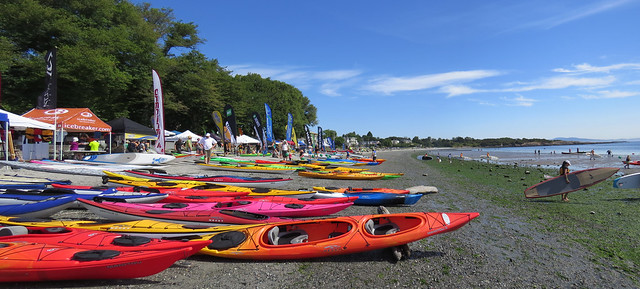
Well, you couldn't ask for a nicer day for a paddlefest, and this year's MEC Victoria Paddlefest hit the weather jackpot. One of the hottest days of the year so far shone down on paddlers of all types as they gathered at Willows Beach to try boats, gear and equipment. Louise and I were there early to check it out.
Stand Up Paddleboarding appears to still be the "next big thing" in paddlesports, but here's an interesting twist that turns it into Sit Down Paddleboarding. It's a contraption that attaches to your paddleboard and turns it into a rowing paddleboard.
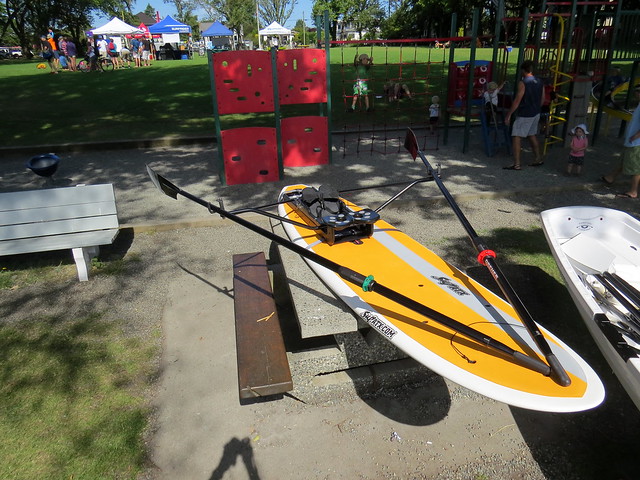
You can even bring along a friend if you like.
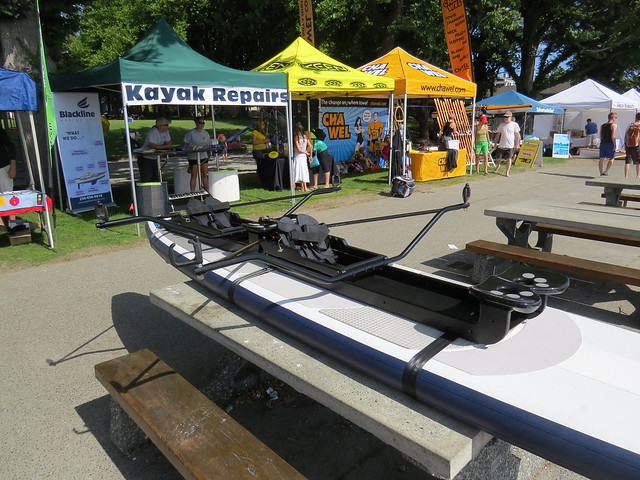
We saw this beautiful boat, a Necky Elias, forlornly lying on its side. What a gorgeous finish.
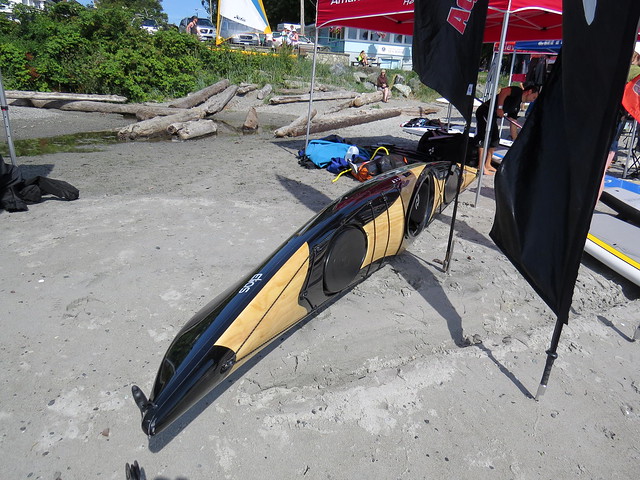
Participants were getting on the water anyway they could....
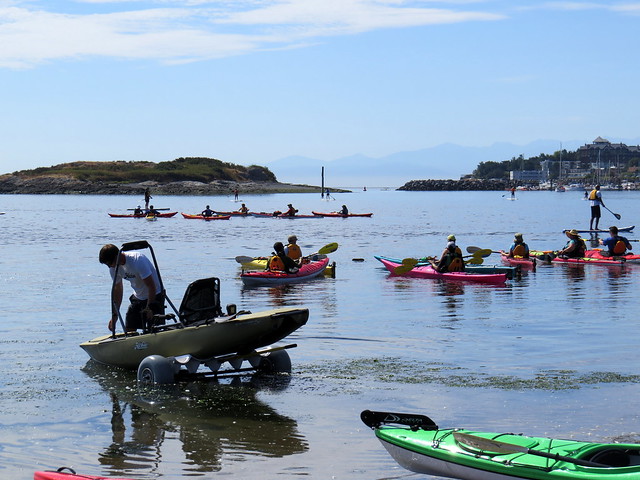
...although a few needed some help.
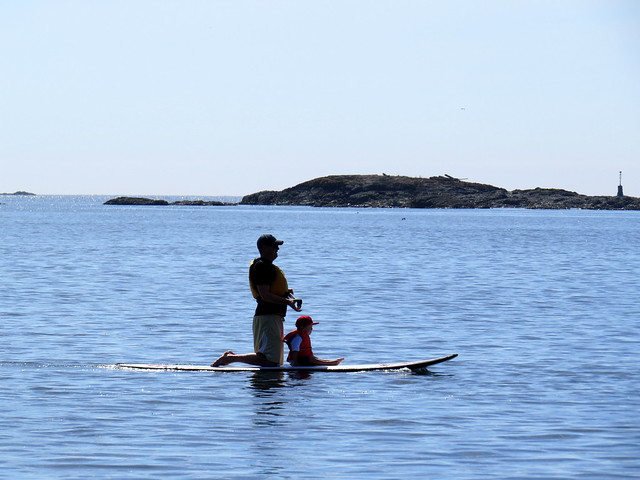
We hadn't planned to hit the water ourselves; I've been nursing a wonky knee for a while, that's one of the reasons why we haven't been out much this year. That, and we really needed to focus on taming our backyard jungle this year before it takes over our whole house. But Louise spotted the new Delta 15s, a boat she has really wanted to try for while. So she suited up and took it out for a spin.
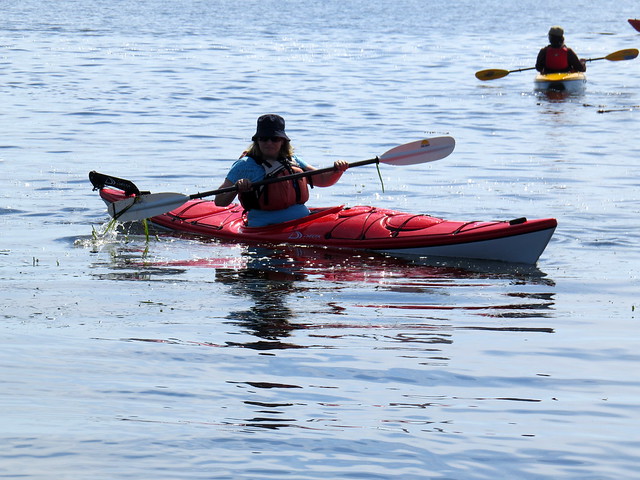

And she loved it. I'm not sure we have room for another kayak! :)
Thursday, July 10, 2014
Think about Grace Islet as a paddler!
Just outside the breakwater is Grace Island, with a shell beach that's exposed at low tide. So neat to look at the tons of crumbling shell and realize that people have been eating clams and oysters here since before the Pyramids were built in Egypt!
John and Louise have paddled past this little island, on their kayaking vacation in April 2012. Alison saw it from the shore of Ganges Harbour on her kayaking vacation in 2012, but didn't get to paddle around it like the rest of us.
 |
| Here's a photo from the Grace Islet Community page on Facebook! |
Now there's a new plan by the owner of the island to build a house there, right among the First Nations traditional burial cairns and open sites. While he does intend to build it on stilts over the remains, a house would cover most of this little islet. These house-building plans have inspired the formation of the Grace Islet Community to call for protected status for this island as a historical First Nations gravesite. You can find out more about the Grace Islet Community at their Facebook Page. Today, their members were speaking at a board meeting of the Capital Regional District at noon. Personally, I wrote to the CRD already on this issue because I am a volunteer naturalist for the CRD, saying briefly:
I have paddled around Grace Islet with my kayak. I respect this traditional place and urge you to preserve it as a historical site, a graveyard, a bird sanctuary, or whatever legislation will keep it unspoiled by the misuse of the current construction project.
thank you,
Paula Johanson
CRD volunteer
Update -- Good News! Grace Islet Community has updated their page with the news that the CRD board has unanimously passed a motion saying:
HEREFORE BE IT RESOLVED THAT the Capital Regional District Board requests that the Ministry of Forest Lands and Natural Resources Operations Archaeology Branch suspend the Alteration Permit issued for Grace Islet, Saltspring Island Electoral Area, to allow consultation and negotiations to proceed between First Nations, the Provincial government and the landowner to ensure protection of this First Nations cultural heritage site. AND BE IT FURTHER RESOLVED THAT the Capital Regional District Board direct staff to convene an inter-governmental meeting in the autumn of 2014 with representatives of First Nations, the Archaeology Branch, the Islands Trust and the CRD to restore trust and identify specific improvements to development approval procedures that will increase protection of First Nations cultural heritage sites within the Capital Region.And you can write to your local MLA if you have an opinion of your own. Since we paddlers are some of the people who pass by this little island and enjoy it without damaging it, we can be good neighbours who can speak to our government representatives about how to manage it as a responsible community.
Kayaking Racing in Sweden
Talk about Old School Kayaking -- skin on frame, no PFDs, and nothing but bathing suits!
Wednesday, July 09, 2014
A Spectacular Kayak Orca Encounter
Monday, July 07, 2014
Rescue Day
Yesterday, the weather was great on Beaver Lake, the narrow end of a vaguely figure-8 shaped lake which we've written many blog posts about as we paddle there a lot. I was out in my little Dragonfly inflatable kayak (a 7-year-old model of what's now called Lagoon), and my friend Heather was rowing her inflatable rowboat (a Seahawk 2 rated as able to carry an adult and a child). These both are awesome little boats for commando kayaking, I should add -- portable, stable, easy to set up, and way way tougher than the cheap little pool toys sold for ten bucks in chain stores. It's easy as pie to carry these boats on the bus and get them to the shore. Turns out, they're reasonable for rescuing tired swimmers, as we were very careful...
 |
| John took this photo a couple of years ago, showing my sporty little boat! |
 |
| Here's the rowboat next to my kayak for size comparison. |
After some relaxed drifting and chatting, Heather said suddenly, "What's that red thing in the water?" We paddled closer to an island to investigate what turned out to be someone's red t-shirt. Someone was swimming among the weeds around the bushy shoreline of the island. He called hello, and asked for a tow.
That's how we met Rob: a young guy in his twenties, tired and tangled in weeds. He took hold of the stern of my kayak and let me tow him out to clear water. There we re-assessed his situation. He was looking for the red canoe he and his dad brought to the island, with a six-pack of beer and a bottle of vodka. Could we please tow him around the island to look for the canoe? He was just too tired to swim through the weeds any more, and his backpack was getting heavy.
"Oh! You have a nice big boat!" he said to Heather. "I'll just get in and ride." He let go of my boat and grabbed for hers. There were weeds wrapped all around his legs and an arm. When we warned him not to flip us, he didn't inspire us with confidence that he could follow orders. It was hard enough for him to take off his backpack when we said so, because it was holding him down in the water. "Man, my electronics are all gonna be soaked," he said unhappily.
Meanwhile, Heather tied her float rope to her seat cushion. With that floating support, Rob was much happier; and with him floating ten feet away, we were much happier. After several tries, I rolled his insanely-heavy pack onto my front deck. There had to be 15 or 20 litres of water in that pack, so I began draining some of the water out through a partly-opened zipper. Peeking in, I saw shoes, jeans, and a plastic bag. Oh yeah, he had soaked whatever phone or camera was in here.
Was it time to push the emergency button on my SPOT beacon and call for rescue? Not quite. Rob could still talk coherently, and held on to his floating cushion fine. Warm day, good weather, and a beach on the lakeshore closer than whatever rock on the other side of the island where his dad and/or red canoe might or might not be, with whatever was left of the beer and vodka.
"Let's get him to shore," said Heather, tying the tow rope to my kayak's stern handle.
"You go ahead," I told her, "And get that nice young man we talked to with the big white truck." She nodded, realizing that if we said the words Emergency Services, Rob might get all upset at the notion of us calling the cops on him. Then he'd be even harder to deal with. Heather rowed to Beaver Beach, while I paddled to North Beach with Rob twenty feet behind me.
(Just for the record, if we hadn't known Emergency Services people were at the beach, we would have sent the emergency signal on the SPOT at that moment, and still begun towing him to shore.)
 |
| Lila took this photo a couple years ago, of me paddling along a similar lake. You'll have to imagine my passenger floating along behind... |
Meanwhile, Heather had reached the shore only to find that the Emergency Services people had left. (We learned later that day that they were called out to another problem with some kids.) She borrowed a phone to call 911. Then she rowed back to the island, where she couldn't see the canoe but could hear Rob's father shouting for him. Good enough! He could stay there for now.
I pushed the OK button to celebrate when I got to shore. Rob staggered ashore and shook my hand. He sat at a picnic table, pulled his jeans and shoes out of his pack, and eventually struggled into them. "It's gonna take me an hour and a half to walk home," he said, and off he went. He wouldn't wait for his dad. Heather met me at North Beach, and we traded stories.
Heather and I went back to Beaver Beach, where a police car was pulled up on the grass close to shore nearly an hour and a half after the 911 call. Officer Brad needed some explanations, and used his radio to tell Fire Rescue to get a boat on the lake to pick up Rob's father. Brad set off to meet them at the Elk Lake end of the lake, and asked us to hang around in case Fire Rescue came to launch here instead. Meanwhile, Heather and I unlocked the Nature Centre. Never been so glad to have the key to that little building!
We folded up our boats, replaced various soggy clothes with dry, and re-fueled with cookies and water. We called my mom for a ride. Just before she got there, Officer Brad came back to tell us that Rob had been found walking along the road. And his father had been found in Elk Lake with a canoe part-way to shore and been rescued because he tipped over just as the Fire Rescue boat reached him. It was 6:45pm.
All in all, a good reminder of why we make such an issue about safety here on the blog -- safety in so many ways:
-the importance of sturdy boats instead of cheap and flimsy pool toys
-familiarity with boat and gear
-experience in various conditions
-safety gear (rope, flotation device, and dunk bag were all put to use)
-safety practise (Heather and I had practised towing in various configurations many times)
-general first aid (doesn't matter much whether someone is impaired by fatigue, a bump on the head, or alcohol if that impaired someone flips your boat and grabs your head -- to avoid that flip, it's much more important to figure out whether that someone is a little impaired or a lot!)
-safe drinking (both Heather and I were dehydrated by the end of our afternoon's adventure -- and I'm wondering if alcohol was a factor in Rob's behavior)
What should we have done differently? In retrospect, since the tired swimmer needed to be towed to shore and his father needed to be found, calling 911 was the right thing to do. The only difference is that we should have used the SPOT emergency signal instead of having one of us paddle to the emergency guys at the beach. The rescue of Rob's father might have been put in motion earlier.
Sunday, July 06, 2014
Rescue
Two people rescued from the lake, all well.
Trains, Planes and Paddlers
Those are fuselages for new Boeing aircraft. They were being transported by rail to the final assembly plant in Everett, Washington when their train derailed in Montana. No injuries were reported. Kyle Massick took some pictures of the aftermath, including this one of paddlers checking out the scene.
Friday, July 04, 2014
Surfski on the Skook
Epic V8 at Skookumchuck Tidal Rapids from Deep Cove Canoe & Kayak Centre on Vimeo.
Thursday, July 03, 2014
BC Marine Trail Network Update
Tuesday, July 01, 2014
River receding. June 22, 2014.
A month after my first foray onto the river for 2014, I was back to see what change time had wrought.
The cherry trees were in full dark leaf, not a blossom to be seen. All the foliage was full and just losing the brilliant emerald of spring. The river had withdrawn from the grass and dropped enough to leave a lip of bank, maybe down about 3-4 feet, although the trees at the edge were still rooted in water.
I paddled up towards the bridge to Île Gagnon, but the current under the bridge still looked brisk, so I decided not to court a dunking quite so early, and turned back, past the launch site and out the Eastern end. Bright blue, cloudless sky, just enough wind to burr the water, water still very brown, silty and opaque. Quite a few kayaks and powerboats out amongst the islands.
I started out by crossing over to the lower part of Île de Juifs, to check whether the channel between Île de Jiufs and Île aux Fraises was still passable; it was, with sufficient attention to the inverted Vs in the water marking rocks. Water was still high enough that the greenery came right down to the water's edge, no bank visible. I paddled west up the channel and out the upstream end, past a spectacular deadfall.
Then west to Île Langlois and across to the south bank and the culvert alongside the Trans-Canada Highway / de Laurentides bridge, which was still passable, though not as much as a month ago. Sheltered, it was still, warm, and scummy, and ruled by red-winged blackbirds. From there I went uneventfully through the tunnel under the Autoroute de Laurentides and steered wide of the people fishing off the embankment to the bridge to Ile Locas. Still a stiff current coming under that bridge, but this time I was prepared for it, and did not get turned around in the eddy. I merely had to work a little. From the other side of the bridge I could see that the platform was once more out near the marsh.
I wanted to check out last month's flooded areas, given the drop in the water level. Île Lacroix had reemerged from the waters and was now fringed with spiky young reeds. A few points along the southern shore were still flooded, and with care I could work my way in amongst the trees and look back out, but the long contiguous passage towards the rear of the marsh that I had explored on my last outing was gone.
The marsh was wide open, with a thin but healthy growth of new reeds sketching in the usual summer limits (my usual panorama shot). I paddled through the reeds and debris, all the way into what later in summer will become an internal pond accessible only by a channel and then as the water drops further, becoming inaccessible. It was windless, with brilliant sunshine sparkling off any flaw in the water, and reeds and foliage perfectly mirrored. The bird watching platform had has been placed on what will probably be edge of the reeds, but right now was far out in the waters. In the still blanched reeds of the northern bank, a unseen heron wheeze-gronked at I don't know what: me? the people on the far bank? passing shadows? her mate? I saw two others in flight around the periphery of the marsh, dark against the emerald trees.
After that, I decided I needed a break, but although there were now several visible steps and a dock at Île Gagnon, there was no beach, and my last attempt at reentry from that dock had ended with me chest deep in warm river for several minutes while I worked out the technique for extracting both feet from the mud. So I circumnavigated the island looking for somewhere I could use as a pull-out that was fairly close to the path, I being in sandals, and not wanting to push my luck after escaping ill-effects from last time's excursions. I found a tree on the water's edge beside the lookout, and I used that as anchor and leverage to help me scramble out onto the slanting, stony, slippery bank. The paths were again paths, rather than canals. I ate my samosas and yoghurt sitting on the bench, and then walked along to the toilet, finding the path up to the toilet shed enthusiastically overgrown. The toilet roll had suffered the depredations of some nest-building critter - the outer layers were shredded, with drifts of small fragments trapped against the base of the shed.
We shall draw a veil over my re-entry. I avoided falling into the water, and I did not lose my sandals, my paddle, or my dignity, although I preserved the latter mainly by making sure no one was within view, and a notable amount of mud came into the cockpit with me.
I was tempted to go back to the marsh for some more photographs, since the sky had begun to fill up with photogenic pebbly white clouds. But there were other places to see. Crossing the main channel from Île des Juifs had convinced me I still did not want to wrestle with the downstream current past Île de Mais (and that I need to get myself into a gym next winter), particularly since a couple of power-boat and aquaskis were already tearing up the main channel. I headed across to the far side of the river to check out road bridge linking Île Morris and then the Pont Gédeon-Ouimet (the one I keep thinking of de Laurentides) for swallow's nests. I caught a glimpse of one or two birds, but the nests I saw were few, old and empty. I only spotted two families of ducklings, one quite mature, and one younger, although I saw very few female mallards.
With the water still high, I could work my way up the channel between Île Lefebvre and Île Morris, through mats of water-lilies and around stands of broken reeds, to the columns supporting the motorway bridge, which rested on mud and just enough water to float a kayak. Something is preying on the water-lily leaves: many of them were yellow, with concentric curving cuts, like paper art (there's a word, but that neuron is just not letting go). On the far side of the motorway bridge, beyond the water, was the rusted relic of an older bridge, one that looked more like a railway bridge than a roadway bridge. From there, I could look eastwards down the channel towards Île Saint-Mars and Île des Lys. As I cleared the reeds nearest the bridge, a flurry of splashing broke out behind me, repeated at intervals in an uneven circuit around the edge of the reeds, with flashes of scale and and fin and slaps on the water. I could track it … whatever it was … by the irregular motions of the reeds. My foremost hypothesis that one of the huge river carp was trying to eat something large and uncooperative - and I was torn between holding the paddle and or the camera, but as the disturbance began working its way towards me, I opted for the paddle, and a slow retreat. Top predator or not, I didn't want that brawl exploding under my keel.
All went quiet for a little while, until something splashed off a fallen log against the shore of Île Lefebvre. I expected to see a muskrat or a maybe even a beaver swimming away, but all I saw was the same pattern of twitching leaves and thrashing headed up towards the bridge. It dawned upon me that I was seeing the big fish brute-forcing their way through the obstacles of reeds and shallows. I tracked a third set of twitching reeds and ripples upstream on a similar transit to the second, during which a broad scaly back broke the surface and unfurled a dorsal fin the size of my five fingers. The closest I knowingly came to one of them was when my brain belatedly caught up with my eyes as I slid my paddle down between lily pads onto a long shadow. I don't know which was more startled, the fish or I.
I then crossed over to explore a section of the riverbank accessible from the shore by a raised walkway, which was still flooded enough to let me through into what must later in summer be a pasture. The water was shallow, still, clear, and noticeably amber, but clean enough to support an abundance of tiny fish, and the occasional larger one, passing through. And turtles. While I was on the landward side, a heron dropped in alongside my exit channel, but I was saved from the decision as to when to disturb it by a quartet of my fellow humans, tramping down the walkway. Not sure whether they even noticed the bird. I spread out my map on my deck to figure out where to go next, and took a panorama shot from the shade of the forest.
Since I'd been playing the 'I'll get the next bus' game with myself for two hours by then, I ducked down behind Île Ducharme to check its bridge for nests - no - and its pullouts for turtles - also no - although I was pleased to see one small house in particular restored from the damage it had suffered during a severe thunderstorm last July. Since I wanted to go under the bridge into the lagoon with the current, that then meant I had to go upstream and around the top of Ile Gagnon, which I did, again via the channel between Ile des Juifs and Ile aux Fraises, and then crossed the channel (and the current) west of Ile Chapleau and Ile Kennedy, took a panorama looking west from Ile Gagnon, and then paddled around the upstream side of Ile Gagnon and raced two kayaks and two canoes to the bridge (I came second). I was trying to get ahead of them in the queue, to make sure I caught my bus - the 1441 73 to Cartier. Despite a few suspenseful moments when it seemed the quartet in front would never focus on the task at hand, I did.
Canada Day on the Gorge
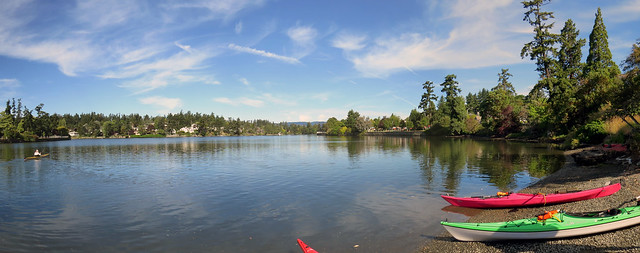
A beautiful sunny morning greeted us as we rolled the kayaks down the hill, and it was only going to get better. Forecast to be the hottest day of the year so far, it's also Canada Day. So Happy 147th Birthday to us!
Every Canada Day, Gorge Road is closed for a mile-long block party. It starts with a parade.
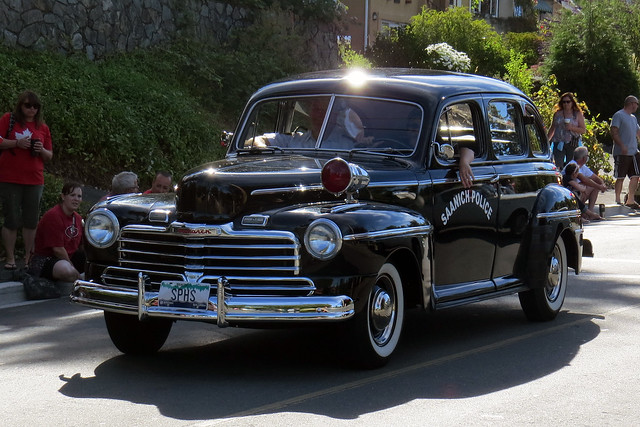
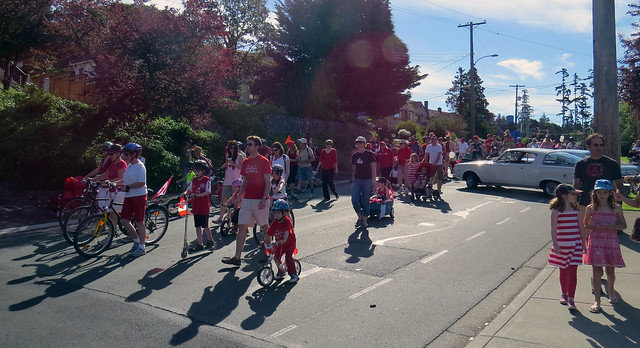
Ace Mascot, the mascot of the local Saanich police came by and surprisingly did not try to arrest me, but gave me a high-five before joining the parade.
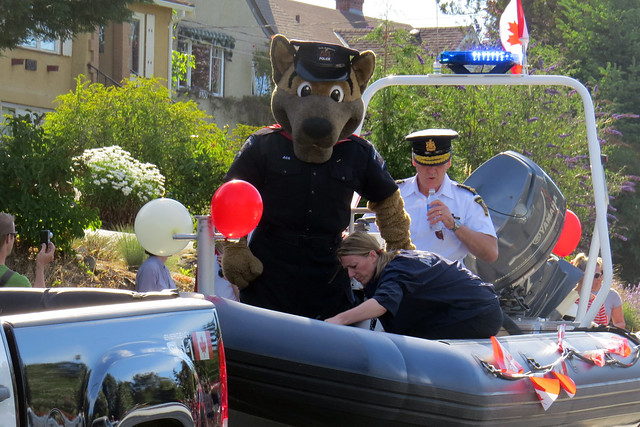
Paula joined Louise and I for our quick little jaunt up the Gorge.
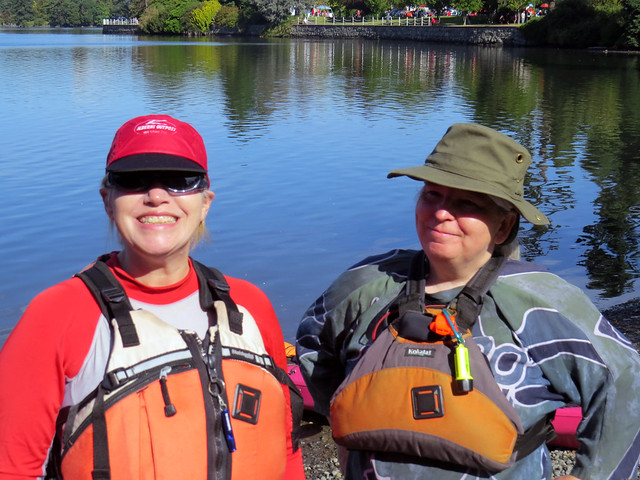
And we're off!
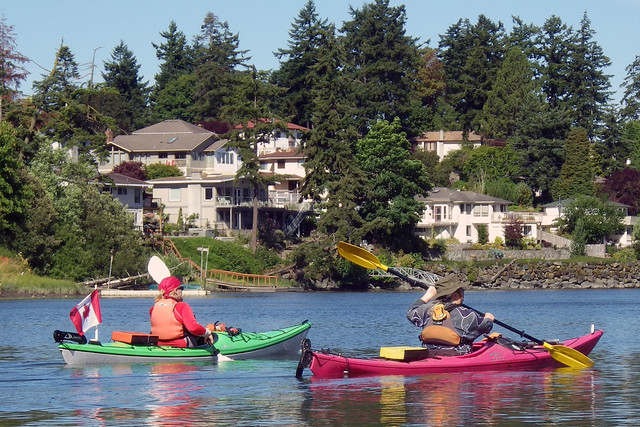
We weren't expecting to see much wildlife today, and we didn't. With all the hustle and bustle, we've come to expect that the wildlife in the area will go into hiding on Canada Day. But we did see a couple of swans enjoying the holiday.
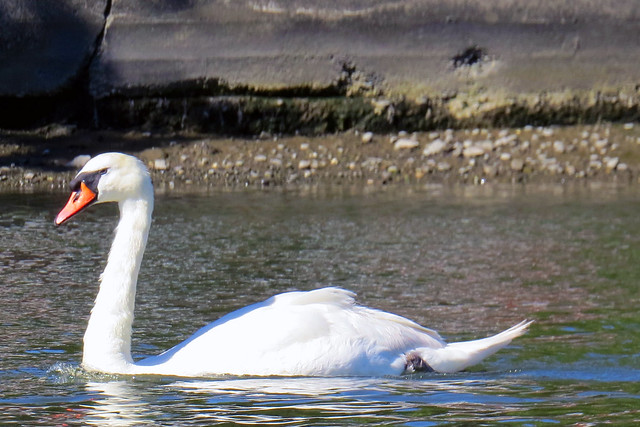
As we paddled down the Gorge...

...we passed the beginning of the parade. Ace was still having a good time.
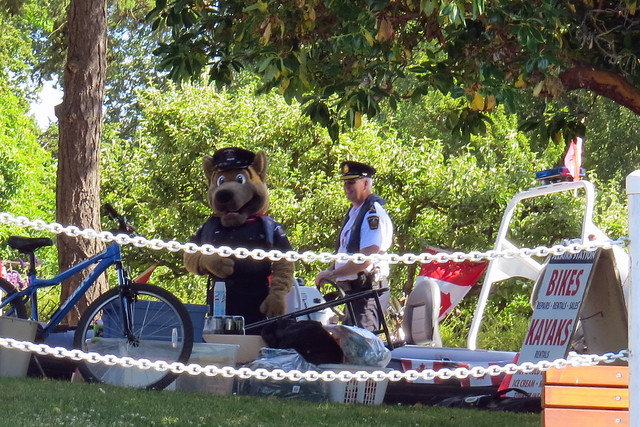
After flying the flag...
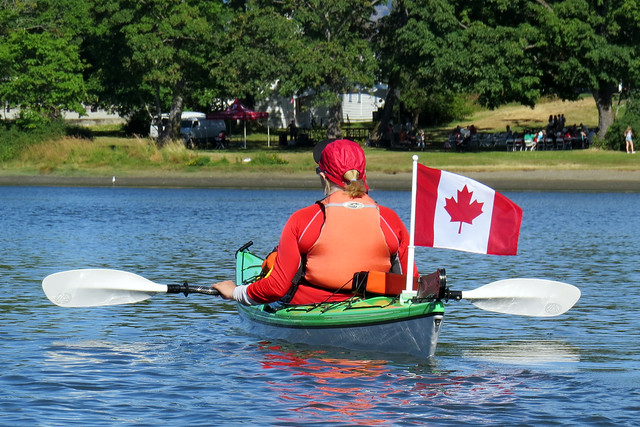
...it was time to join the street party.
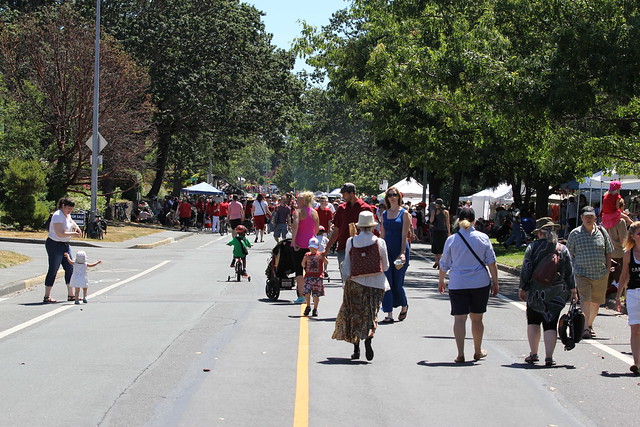
We checked out the classic chairs...
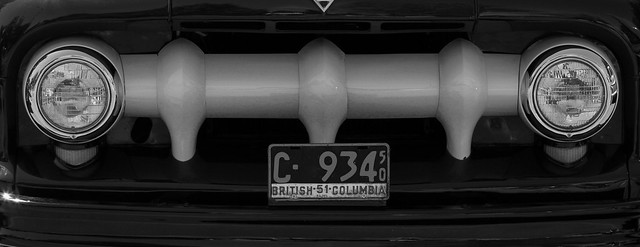
...and the artisan booths.
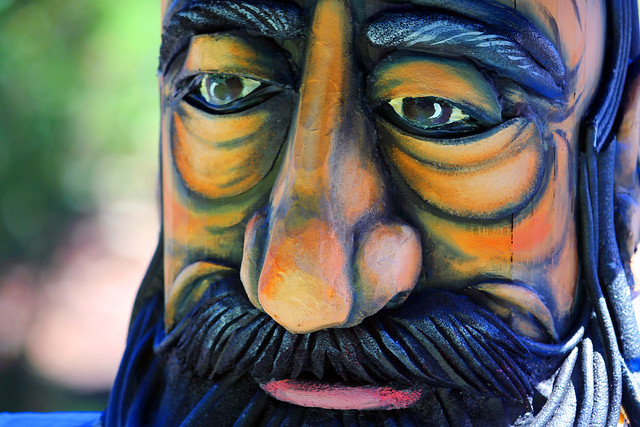
And we checked out the road hockey tournament. After all, what's more Canadian than hockey in July?
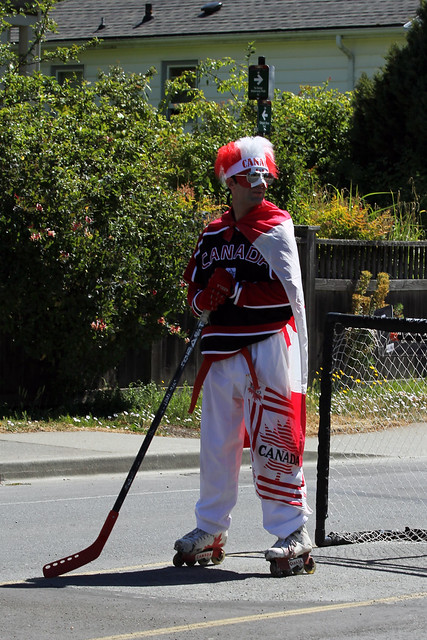
Trip length: 3.81 km
YTD: 29.89 km
More pictures are here.
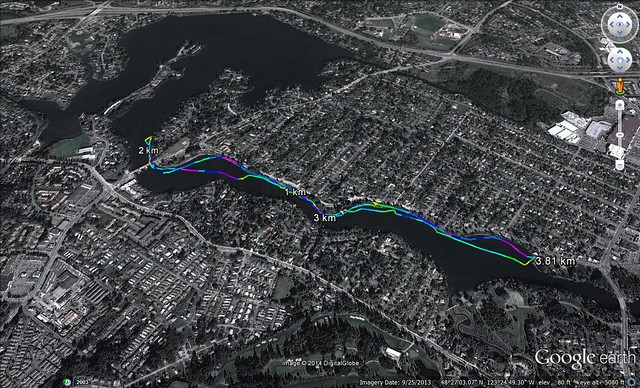
Building a Kayak
Part One:
Part Two:


